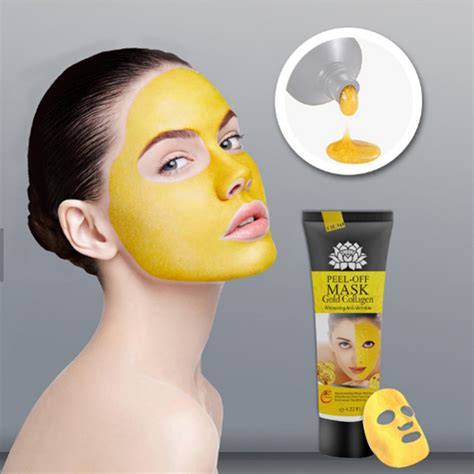Introduction to Peel-off Masks
Peel-off masks have become increasingly popular in recent years as a quick and easy way to achieve glowing, healthy-looking skin. These masks are designed to be applied to the face, allowed to dry, and then peeled off, taking with them any impurities, dead skin cells, and excess oil. In this article, we will explore what peel-off masks are, how they work, and their benefits for the skin.
How Peel-off Masks Work
Peel-off masks typically contain a combination of ingredients that work together to create a thick, gel-like consistency. When applied to the skin, the mask begins to dry and harden, forming a thin, flexible sheet that can be peeled off in one piece. As the mask dries, it adheres to the skin, drawing out impurities and excess oil from the pores.
The key ingredients in peel-off masks often include:
- Polyvinyl alcohol (PVA): This polymer creates the thick, gel-like consistency of the mask and allows it to be peeled off easily.
- Glycerin: A humectant that helps to hydrate and soften the skin.
- Charcoal or clay: These ingredients help to draw out impurities and excess oil from the pores.
- Botanical extracts: Many peel-off masks contain ingredients like tea tree oil, aloe vera, or chamomile to soothe and nourish the skin.

Benefits of Peel-off Masks
1. Deep Cleansing
One of the primary benefits of peel-off masks is their ability to deeply cleanse the skin. As the mask dries and hardens, it adheres to the skin, drawing out impurities, dirt, and excess oil from the pores. This deep cleansing action can help to prevent breakouts and leave the skin looking clearer and more refined.
2. Exfoliation
Peel-off masks also provide a gentle form of exfoliation, helping to remove dead skin cells and promote cell turnover. As the mask is peeled away, it takes with it any dead skin cells that may be clinging to the surface of the skin, revealing a brighter, smoother complexion.
3. Pore Refinement
By drawing out impurities and excess oil from the pores, peel-off masks can help to temporarily refine and minimize the appearance of pores. This can create a smoother, more even skin texture and a more youthful-looking complexion.
4. Hydration
Many peel-off masks contain hydrating ingredients like glycerin or hyaluronic acid, which can help to moisturize and plump the skin. This can be especially beneficial for those with dry or dehydrated skin, as it can help to restore the skin’s natural moisture balance.
5. Relaxation
Applying a peel-off mask can be a relaxing and pampering experience, providing a moment of self-care and indulgence. The act of taking time for oneself and focusing on skincare can be a great way to reduce stress and promote a sense of well-being.

How to Use Peel-off Masks
Using a peel-off mask is a simple process that can be done in the comfort of your own home. Here’s a step-by-step guide:
- Cleanse your face thoroughly with a gentle cleanser to remove any dirt, oil, or makeup.
- Apply the peel-off mask evenly to your face, avoiding the eye area and hairline. Use a brush or your fingers to ensure an even application.
- Allow the mask to dry completely. This usually takes around 15-20 minutes, depending on the thickness of the application.
- Once the mask is completely dry, start peeling it off from the edges, working your way towards the center of your face. If the mask is difficult to remove, you can use a warm, damp cloth to help loosen it.
- After removing the mask, rinse your face with cool water and pat dry with a clean towel.
- Follow up with your regular skincare routine, applying toner, serum, and moisturizer as needed.
It’s important to note that peel-off masks should be used in moderation, typically no more than once or twice a week. Overuse can lead to dryness, irritation, or sensitivity, especially for those with delicate skin.

Types of Peel-off Masks
There are many different types of peel-off masks available, each designed to target specific skin concerns. Some common types include:
1. Charcoal Peel-off Masks
Charcoal peel-off masks are formulated with activated charcoal, which is known for its ability to draw out impurities and toxins from the skin. These masks are particularly beneficial for those with oily or acne-prone skin, as they can help to unclog pores and reduce the appearance of blackheads.
2. Glitter Peel-off Masks
Glitter peel-off masks are a fun and trendy option that combine the benefits of a traditional peel-off mask with the added appeal of sparkly glitter. These masks can help to brighten and revitalize the skin while providing a playful and Instagram-worthy experience.
3. Metallic Peel-off Masks
Metallic peel-off masks, often in shades of gold or silver, are another popular option that can help to brighten and illuminate the skin. These masks often contain ingredients like pearl powder or colloidal gold, which are believed to have anti-aging and brightening properties.
4. Fruit Enzyme Peel-off Masks
Fruit enzyme peel-off masks are formulated with natural fruit extracts like papaya, pineapple, or pumpkin, which contain enzymes that can help to gently exfoliate and brighten the skin. These masks are often a good choice for those with sensitive skin, as they provide a more gentle form of exfoliation compared to traditional physical exfoliants.
Peel-off Masks vs. Other Types of Masks
Peel-off masks are just one type of facial mask available, and they offer distinct benefits compared to other types of masks. Here’s a quick comparison:
| Mask Type | Key Benefits | Application |
|---|---|---|
| Peel-off Masks | Deep cleansing, exfoliation, pore refinement | Applied evenly to face, allowed to dry, then peeled off |
| Sheet Masks | Hydration, nourishment, soothing | Applied to face, left on for 15-20 minutes, then removed |
| Clay Masks | Deep cleansing, oil absorption, pore refinement | Applied evenly to face, left on until dry, then rinsed off |
| Cream Masks | Hydration, nourishment, anti-aging | Applied evenly to face, left on for 10-15 minutes, then rinsed off |
Ultimately, the type of mask you choose will depend on your individual skin concerns and preferences. Many people find that incorporating a variety of mask types into their skincare routine can provide a more comprehensive approach to maintaining healthy, glowing skin.
DIY Peel-off Mask Recipes
For those who enjoy a bit of DIY skincare, it’s possible to make your own peel-off masks at home using simple, natural ingredients. Here are a few easy recipes to try:
1. Gelatin and Milk Peel-off Mask
- 1 tbsp unflavored gelatin powder
- 2 tbsp milk
- 1 tsp honey
Mix the ingredients together in a microwave-safe bowl and heat for 10-15 seconds, until the gelatin has dissolved. Allow the mixture to cool slightly, then apply to the face and let dry for 15-20 minutes before peeling off.
2. Egg White and Tissue Peel-off Mask
- 1 egg white
- Facial tissue
Separate the egg white from the yolk and whisk until frothy. Apply a thin layer of the egg white to your face, then place small pieces of facial tissue over the top, pressing gently to adhere. Apply another layer of egg white over the tissue and let dry completely before peeling off.
3. Charcoal and Glue Peel-off Mask
- 1 tsp activated charcoal powder
- 1 tbsp non-toxic white glue
- 1 tsp water
Mix the ingredients together until well combined, then apply to the face, avoiding the eye area and hairline. Let dry completely, then peel off gently.
When making DIY peel-off masks, it’s important to patch test the ingredients first to ensure you don’t have any adverse reactions. It’s also crucial to use non-toxic, skin-safe ingredients and to avoid applying the masks too frequently, as this can lead to irritation or dryness.
Precautions and Potential Side Effects
While peel-off masks are generally safe and well-tolerated, there are a few precautions to keep in mind:
- Always do a patch test before applying a new mask to your face, especially if you have sensitive skin or are prone to allergies.
- Avoid applying peel-off masks too frequently, as this can lead to dryness, irritation, or sensitivity. Stick to using them no more than once or twice a week.
- Be gentle when peeling off the mask, as tugging or pulling too hard can cause irritation or even damage to the skin.
- If you experience any redness, itching, or burning while the mask is on, remove it immediately and rinse your face with cool water.
In rare cases, some people may experience more severe side effects from peel-off masks, such as allergic reactions or skin irritation. If you notice any concerning symptoms, discontinue use and consult with a dermatologist or healthcare provider.
Frequently Asked Questions (FAQ)
- Are peel-off masks suitable for all skin types?
- Peel-off masks can be suitable for most skin types, but those with sensitive or very dry skin may find them too drying or irritating. It’s always best to do a patch test first and to choose a mask formulated for your specific skin type.
- How often should I use a peel-off mask?
- It’s generally recommended to use peel-off masks no more than once or twice a week to avoid over-drying or irritating the skin. However, the ideal frequency may vary depending on your individual skin type and concerns.
- Can I use a peel-off mask if I have active acne or breakouts?
- While some peel-off masks may help to unclog pores and reduce the appearance of blackheads, it’s generally best to avoid using them on active acne or open wounds, as this can cause further irritation or even infection. If you have active breakouts, opt for a gentler mask or consult with a dermatologist for advice.
- How long should I leave a peel-off mask on for?
- Most peel-off masks should be left on until completely dry, which typically takes around 15-20 minutes. However, always follow the instructions provided with your specific mask, as leaving it on for too long can lead to dryness or irritation.
- Can I use a peel-off mask on other parts of my body besides my face?
- While peel-off masks are primarily designed for use on the face, some people do use them on other areas like the neck, chest, or hands. However, it’s important to be cautious when using them on more sensitive areas and to patch test first to ensure you don’t have any adverse reactions.
Conclusion
Peel-off masks are a popular and effective way to deep cleanse, exfoliate, and refresh the skin, providing a range of benefits for various skin types and concerns. By understanding how these masks work, the different types available, and the proper way to use them, you can incorporate peel-off masks into your skincare routine for brighter, healthier-looking skin. Whether you opt for a store-bought version or try your hand at a DIY recipe, peel-off masks offer a fun and satisfying way to pamper your skin and promote a glowing complexion.






Leave a Reply